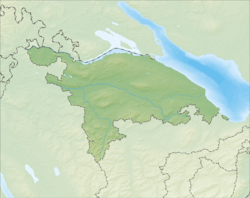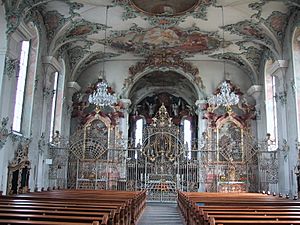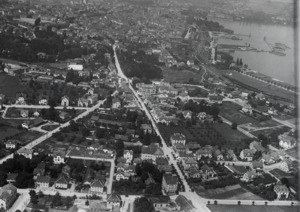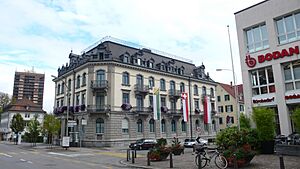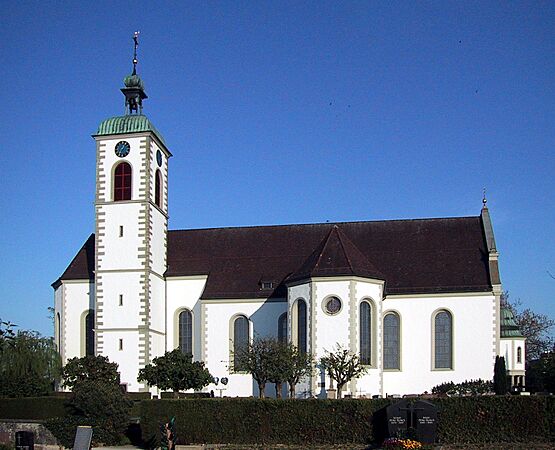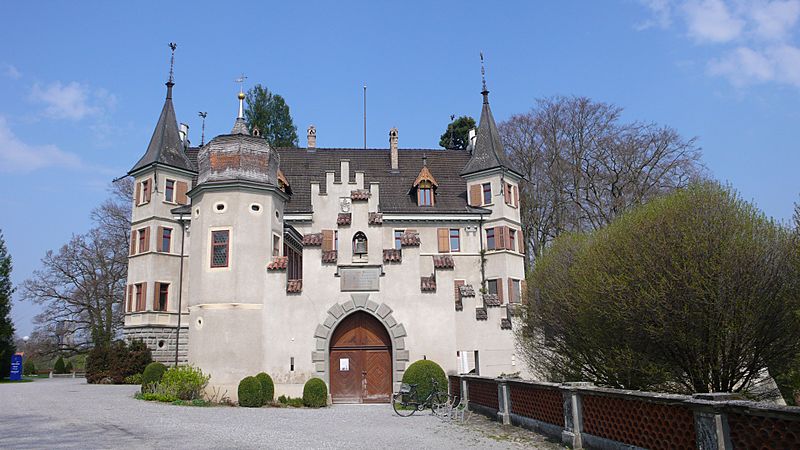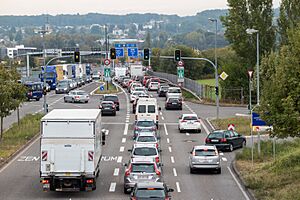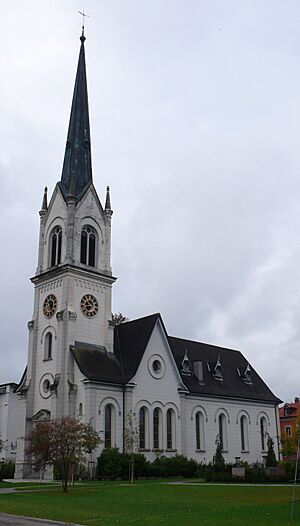Kreuzlingen facts for kids
Quick facts for kids
Kreuzlingen
|
||
|---|---|---|
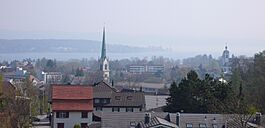
Kreuzlingen in April 2010
|
||
|
||
| Country | Switzerland | |
| Canton | Thurgau | |
| District | Kreuzlingen | |
| Area | ||
| • Total | 11.5 km2 (4.4 sq mi) | |
| Elevation | 397 m (1,302 ft) | |
| Population
(Dec 2020 )
|
||
| • Total | 22,390 | |
| • Density | 1,947/km2 (5,043/sq mi) | |
| Postal code |
8280
|
|
| Localities | Emmishofen, Kurzrickenbach | |
| Surrounded by | Bottighofen, Constance (Konstanz) (DE-BW), Kemmental, Lengwil, Tägerwilen | |
| Twin towns | Wolfach (Germany), Cisternino (Italy) | |
Kreuzlingen is a town in north-eastern Switzerland. It's located in the Thurgau canton, right next to Lake Constance. Kreuzlingen is the second-largest city in its canton, with about 22,000 people living there. It's also part of a larger area with the German city of Konstanz, making it a big community of almost 120,000 people.
Contents
Discovering Kreuzlingen's Past
The name Kreuzlingen comes from an old monastery called Crucelin. This monastery was founded in 1125 by a bishop named Ulrich I. During wars, like the Swabian War and the 30 Years' War, the monastery was burned down. People from Konstanz thought the monks helped their enemies.
In 1650, the monastery was rebuilt in its current spot. Later, in 1848, the buildings became a school for teachers. The chapel of the monastery became a Catholic church.
People lived in this area a very long time ago, even during the Bronze Age. Old coins and items from the Celtic and Roman times show that people kept living here. Some parts of Kreuzlingen, like Kurzrickenbach and Emmishofen, were first mentioned in very old writings from the 800s and 1100s.
For a long time, the land belonged to the Bishop of Konstanz. But when the Swiss took over Thurgau in 1460, and after the Protestant Reformation, the ties to Konstanz became weaker.
How Kreuzlingen Grew into a Town
At the start of the 1800s, Kreuzlingen was mostly farmland. But things changed with new technology. Steamboats started sailing on Lake Constance in 1824. Then, train lines were built in 1871 and 1875. These new ways to travel brought more trade and factories to the area.
In 1874, a nearby village called Egelshofen was renamed Kreuzlingen. It became the main town of the district. Kreuzlingen grew even bigger when it joined with Kurzrickenbach in 1927 and Emmishofen in 1928.
Before World War I, Kreuzlingen was almost like a suburb of Konstanz. Many of its businesses were owned by German companies. But the war helped Kreuzlingen become more independent. In 1947, Kreuzlingen had more than 10,000 residents. This meant it was officially considered a town in Switzerland.
A special hospital called the Sanatorium of Bellevue was important to Kreuzlingen's history. It was open from 1857 to 1980 and used part of the old monastery buildings. A psychiatrist named Ludwig Binswanger bought the property in 1857 and opened the private hospital. It was very modern for its time. Important new ideas in mental health care were developed there.
Exploring Kreuzlingen's Landscape
Kreuzlingen covers an area of about 11.5 square kilometers (4.4 square miles). A big part of this land is used for farming (27.2%). Another large part is covered by forests (28.2%). The biggest portion, about 42.4%, is built-up with buildings and roads.
A small amount of land (1.0%) is rivers or lakes. The rest (1.1%) is land that can't be used for farming or building.
Kreuzlingen is located right on the border with the German city of Konstanz. It sits on Lake Constance, where the lake gets narrower. It's also halfway between the cities of Schaffhausen and Rorschach. The town includes what used to be the villages of Bernrain, Egelshofen, Emmishofen, and Kurzrickenbach.
People and Population in Kreuzlingen
Kreuzlingen has a population of over 22,000 people. About 48.1% of the people living here are from other countries. Over the last 10 years, the population has grown by about 2.2%.
Most people in Kreuzlingen speak German (79.7%). The next most common languages are Italian (5.2%) and Albanian (3.8%).
In 2008, there were slightly more women (50.8%) than men (49.2%) living in Kreuzlingen. The number of Swiss citizens went down a little, while the number of people from other countries went up. Overall, the population grew by 1.5% in 2008.
Age Groups in Kreuzlingen
Looking at the age groups in 2009:
- Children aged 0-9 made up 8.7% of the population.
- Teenagers aged 10-19 made up 10.1%.
- Young adults aged 20-29 made up 14.5%.
- Adults aged 30-59 made up 44% (this includes several groups).
- Seniors aged 60 and older made up 22.8%.
In 2000, there were about 7,643 homes in Kreuzlingen, with an average of 2.1 people per home. Most homes were single-family houses. Many people lived in couples with or without children.
Historical Population Growth
Here's how Kreuzlingen's population has grown over time:
| year | population |
|---|---|
| 1831 | 661 |
| 1870 | 1,471 |
| 1880 | 2,426 |
| 1920 | 5,740 |
| 1930 | 8,615 |
| 1950 | 10,045 |
- Population of Egelshofen
Important Heritage Sites
Kreuzlingen has some very important historical places. These are called heritage sites of national significance. They include:
- The old Augustinian monastery of St Ulrich.
- The former granary (where grain was stored) and wine press at Seeburgscheune.
- Seeburg Castle.
The whole area around the Untersee (part of Lake Constance) is also a protected heritage site.
Kreuzlingen's Economy and Jobs
In the past, many people in Kreuzlingen worked in the wine industry. But because of plant diseases and bad harvests, the last wine grapes were grown here in 1938. Today, Kreuzlingen's economy is mostly about trade and manufacturing. A clothing company is the biggest employer.
In 2007, the unemployment rate in Kreuzlingen was 3.54%. In 2005, a small number of people worked in farming (92 people). Many more worked in manufacturing (2,799 people). The largest number of jobs (6,042 people) were in the service sector, like shops, offices, and hotels.
In recent years, many shoppers from Kreuzlingen and other parts of Switzerland have started going to Konstanz in Germany to shop. This is because prices for basic items are lower in Germany. Also, the exchange rate between the Euro and the Swiss Franc is good for Swiss shoppers. Plus, they can get a refund on the German sales tax, which saves them even more money.
This has made it harder for shops in downtown Kreuzlingen. City leaders have asked the Swiss government to talk to Germany about this. At the same time, some people from Konstanz have opened businesses in Kreuzlingen that mostly serve other Germans.
Kreuzlingen is also home to General Dynamics European Land Systems-Mowag (GDELS). This company makes defense technology. In 2012, it had 900 skilled workers, but it also announced plans to reduce some jobs.
Religion in Kreuzlingen
According to the 2000 census, most people in Kreuzlingen were Christian (74.45%). Of these, about 37% were Roman Catholic and 31% belonged to the Swiss Reformed Church.
There were also people who belonged to the Orthodox Church (3.69%) and other Christian churches (2.68%). A smaller number of people were Jewish (0.06%). About 12.06% of the population were Islamic.
Around 8.95% of the people said they didn't belong to any church, or were agnostic or atheist.
Learning and Education
In Kreuzlingen, about 63.2% of adults (aged 25–64) have finished either high school or gone on to higher education, like university.
Kreuzlingen has its own primary school district and a secondary school district.
In the 2008/2009 school year, there were 1,191 students in primary schools. This included 290 children in kindergarten. The average class size in primary school was about 17 students. Many students in primary school were female, not Swiss citizens, or did not speak German as their first language.
In secondary schools, there were 622 students. Students are grouped based on their performance. The average class size for secondary school was about 19.73 students.
Kreuzlingen also has a main library called the Stadt- und Berufsschulbibliothek. In 2008, the library had over 22,870 books and other media. It loaned out more than 120,000 items that year.
Getting Around: Transportation
Kreuzlingen is an important place for trains. It's also where the A7 motorway in Switzerland ends.
Sports and Fun
FC Kreuzlingen is the town's football (soccer) club.
Kreuzlingen is also well-known for Water polo in Switzerland. The SC Kreuzlingen team has won the Swiss Championship a total of 9 times!
Famous People from Kreuzlingen
Many interesting people have connections to Kreuzlingen:
- August Gremli (1833–1899) – A doctor and botanist (someone who studies plants).
- Enrique Conrado Rebsamen Egloff (1857-1904) – An educator who helped set up schools for teachers in Mexico.
- Ludwig Binswanger (1881–1966) – A psychiatrist who was a pioneer in a field called existential psychology.
- Libero De Luca (1913–1998) – A tenor (a type of singer) known for French music.
- Armin Schibler (1920–1986) – A composer and music professor.
- Erich Peters (1920–2012) – A Swedish gymnast who competed in the 1952 Summer Olympics.
- Cesar Lüthi (1930–2002) – A businessman known for sports marketing.
- Timon Altwegg (born 1967) – A classical pianist.
- Claudio Imhof (born 1990) – A track cyclist.
See also
 In Spanish: Kreuzlingen para niños
In Spanish: Kreuzlingen para niños




